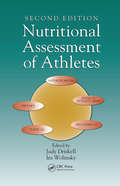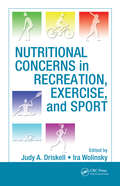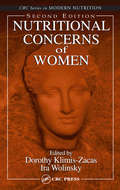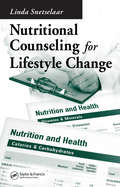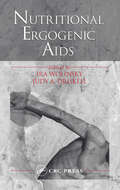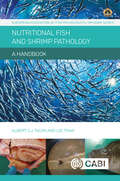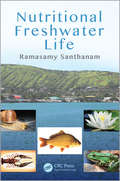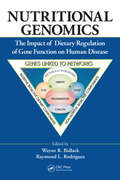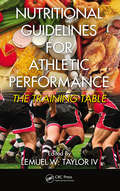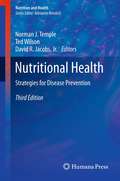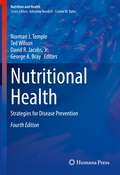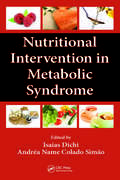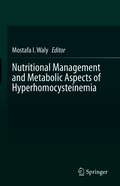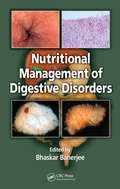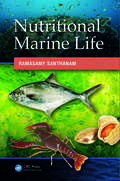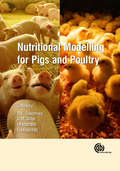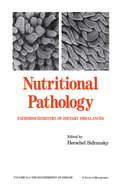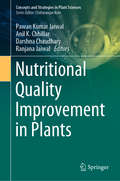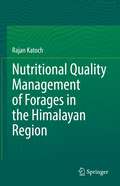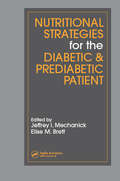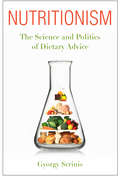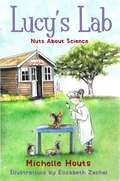- Table View
- List View
Nutritional Assessment of Athletes
by Judy A. Driskell Ira WolinskyNutritional assessment is a key to determining the health and performance efficiency of professional, collegiate, and recreational athletes. Expanded to include new chapters, the second edition of Nutritional Assessment of Athletes examines the dietary, nutritional, and physical needs of athletes and describes critical biochemical and cli
Nutritional Care of the Patient with Gastrointestinal Disease
by Alan L BuchmanNutritional management is an integral part of the management for virtually all gastrointestinal diseases. Nutritional Care of the Patient with Gastrointestinal Disease fills a current void in nutritional education by providing a reference for diagnosing and managing common nutritional issues related to gastrointestinal disease. Its separation into
Nutritional Concerns in Recreation, Exercise, and Sport
by Judy A. Driskell Ira WolinskyAthletes, coaches, and recreationalists are continually seeking ways to maximize their competitive efforts in both exercise and sport, and from 5km runners to Olympians, most athletes recognize that good nutrition is as crucial to success as ongoing practice and regular exercise. Written and edited by top-notch nutrition and exercise authorities, N
Nutritional Concerns of Women
by Dorothy Klimis-Zacas Ira WolinskyWomen's health and nutrition concerns have moved to the forefront of research with the mandate by the National Institutes of Health to include women in formerly male-only studies assessing responses to diet and disease. This second edition of a popular and highly praised resource provides new research results that detail the prevalence of and diffe
Nutritional Counseling for Lifestyle Change
by Linda SnetselaarNutrition plays a role in the causes, treatment, and/or management of many chronic diseases, yet the physician's primary responsibility is to treat through medication. Translating research findings and clinical experience into practical treatment recommendations, the book focuses on alleviating chronic illnesses with nutritional support and interve
Nutritional Ergogenic Aids
by Irawolinsky Judy A DriskellNutritional Ergogenic Aids provides an up-to-date review of what is hypothetical and what is known about the most extensively used nutritional ergogenic aids; dietary supplements to enhance physical and athletic performance. Among the 23 aids discussed are branched-chain amino acids, carnitine, creatine, glucosamine, chrondroitin sulfate and taurine. An up-to-date review about what is hypothetical and what is known about the most extensively used ergogenic aids.
Nutritional Fish and Shrimp Pathology: A Handbook (European Association of Fish Pathologists (EAFP))
by Albert Tacon Loc TranCorrect nutrition in farmed animals is essential to healthy stock and an economically sustainable high yield. In aquaculture, nutrition is particularly important as the costs of feed can be 40 or 50% of total production costs. In recent years, the aquaculture feed industry has advanced rapidly with the introduction of many commercially available feeds containing scientifically formulated and balanced diets to enhance growth and yield in specific species. Many feeds also now include ingredients aimed particularly at enhancement of stock health. The field of nutritional pathology is concerned with the study of those health disorders and ailments that result from nutrient deficiencies or dietary imbalances. This exciting new book provides an up-to-date and user-friendly practical guide on nutritional pathology in the main commercially farmed species of fish and shrimp. The book commences with an overview of the importance of nutrition in health management and the interaction between culture system, disease and the environment. The book then covers disorders in protein nutrition, lipid nutrition, mineral nutrition and vitamin nutrition. The book also encompasses comprehensive details of endogenous plant anti-nutritional factors, exogenous feed contaminants and feed biosecurity. Nutritional Fish and Shrimp Pathology: A Handbook is an ideal resource for personnel within the aquaculture industry and suppliers to the industry, particularly personnel within animal feed companies and animal health companies, especially any scientist responsible for feed formulation within animal feed companies. Fish farm managers and technicians will also find it useful, as well as companies providing fish-feeding equipment, personnel within universities and research establishments where aquaculture is studied and taught, including biochemists, chemists, biological scientists, fish pathologists, food and feed scientists, nutritionists, fish veterinarians, animal scientists and aquaculture scientists. The book will also provide a reference for students who are taking up courses such as Fish Nutritional Biochemistry, Fish Health, and Fish Nutrition and Feed Formulation, amongst others.
Nutritional Freshwater Life
by Ramasamy SanthanamSupplying sustenance for millions of the poorest people in the world, freshwater flora and fauna also contribute to overall economic well-being by means of export commodity trade, tourism, and recreation. As sources of high-quality nutrients, freshwater flora and fauna of edible value represent a viable option for alleviating the problems related t
Nutritional Genomics: The Impact of Dietary Regulation of Gene Function on Human Disease
by Wayne R. Bidlack Raymond L. RodriguezThe notion of matching diet with an individual's genetic makeup is transforming the way the public views nutrition as a means of managing health and preventing disease. To fulfill the promise of nutritional genomics, researchers are beginning to reconcile the diverse properties of dietary factors with our current knowledge of genome structure and g
Nutritional Guidelines for Athletic Performance: The Training Table
by Lemuel W. Taylor IVBasic nutrition requirements and proper training are the two most important factors for athletes to achieve peak performance levels. This volume addresses these needs on a comprehensive basis from a training table perspective. Offering practical guidelines for practitioners and athletes, the book focuses on the key macronutrients that fuel daily metabolism and exercise training, and explores differing needs for various athletes and their individual goals. It discusses how to determine body weight for a desired body fat percentage, recommended calorie consumption, dietary suggestions, and useful meal planning tools for a wide variety of caloric needs.
Nutritional Health
by David R. Jacobs Jr. Norman J. Temple Ted WilsonNow going into its third much-expanded edition, the highly praised Nutritional Health: Strategies for Disease Prevention has been brought fully up to date to include all the new thinking and discoveries that have the greatest capacity to improve human health and nutritional advancement. About half the new edition will be revised and updated from the second edition while the other half will consist of major revisions of previous chapters or new subjects. Like the two previous editions the book will consist of general reviews on various topics in nutrition, especially those of much current interest. The authors provide extensive, in-depth chapters covering the most important aspects of the complex interactions between diet, its nutrient components, and their impacts on disease states, and on those health conditions that increase the risk of chronic dieases. Up to date and comprehensive, Nutritional Health: Strategies for Disease Prevention, Third Edition offers physicians, dietitians, and nutritionists a practical, data-driven, integrated resource to help evaluate the critical role of nutrition.
Nutritional Health: Strategies for Disease Prevention (Nutrition and Health)
by Norman J. Temple Ted Wilson David R. Jacobs Jr. George A. BrayThis fourth edition brings together a diverse range of experts in nutrition-related areas to discuss recent thinking and discoveries in nutrition, especially in relation to topics that have the greatest capacity to improve human health and nutritional implementation. An overview of nutrition science in the third decade of the twenty-first century reveals that much water has flown under the bridge of the advancing river that is nutrition research and practice. With these large accumulations of developments in the field of nutrition, the need for a new edition of this book is obvious. Our vastly improved nutrition knowledge gives us the capability of preventing a sizable fraction of the chronic diseases that afflict the people of our world, but only if these discoveries can be translated into effective action at the population level. Nutritional Health endeavours to address the needs of those who would most benefit from up-to-date information on key areas in the field of nutrition.The book starts with a discussion of the nature of nutritional research then moves into an overview of the most important aspects of the complex interactions between diet, its nutrient components, and their impacts on disease states, and on those health conditions that increase the risk of chronic diseases. Parts three and four discuss diet and include new chapters on the Mediterranean diet, the DASH diet, the flexitarian diet, and the low-carbohydrate diet. The final two parts of the book discuss emerging trends in nutrition science, such as gut microbiome and sustainable diet, and areas of controversy in nutrition, such as the influence of the food industry and dietary supplements. Up to date and comprehensive, Nutritional Health: Strategies for Disease Prevention, Fourth Edition offers physicians, dietitians, and nutritionists a practical, data-driven, integrated resource to help evaluate the critical role of nutrition.
Nutritional Intervention in Metabolic Syndrome
by Isaias Dichi Andréa Name Colado SimãoMetabolic syndrome (MS) is a combination of medical disorders that, when occurring together, increase the risk of developing cardiovascular disease and diabetes. The prevalence of MS is rising in developing countries and developed countries, now considered a pandemic disease. This book presents information on how to treat MS through lifestyle change and nutritional intervention. Chapters cover prevalence of MS; pathophysiology; MS in systemic lupus erythematosus and rheumatoid arthritis; gene-nutrient interactions; MS in adolescents and children; lifestyle change and physical activity; and various effects of dietary components in MS.
Nutritional Management and Metabolic Aspects of Hyperhomocysteinemia
by Mostafa I. WalyElevated blood concentrations of homocysteine, B vitamins deficiencies and oxidative stress are etiological factors for many human chronic diseases, yet the etiologic relationship of hyperhomocysteinemia to these disorders remains poorly understood. Clinical trials continue to support the notion that hyperhomocysteinemia is involved in the pathogenesis of oxidative stress and its associated impairment of cellular redox status. Antioxidants, phytochemicals, and bioactive agents are thought to be associated with the reduction of oxidative stress and reducing risk of chronic diseases, yet their role in preventing hyperhomocysteinemia-mediated oxidative stress has not been well covered in the literature. Nutritional Management and Metabolic Aspects and of Hyperhomocysteinemia comprehensively covers the nutritional-based intervention for combating hyperhomocysteinemia-mediated oxidative stress, metabolic regulation of homocysteine-dependent transulfuration and transmethylation pathways, and the identification of novel biomarkers for early diagnosis of hyperhomocysteinemia. The main goal of this text is to address the biochemical and nutritional aspects of hyperhomocysteinemia in relation to increasing risk of chronic diseases, providing insight into the etiology of hyperhomocysteinemia and covering new research on the effective reduction and management of hyperhomocysteinemia-associated chronic diseases. For researchers seeking a singular source for the understanding of the biochemical aspects and nutrition-based combat of hyperhomocysteinemia, its risk factors, preventive measures, and possible treatments currently available, this text provides all of the important needed information in up-to-date and comprehensive form.
Nutritional Management of Digestive Disorders
by Bhaskar BanerjeeThanks to new tools of research and the heightened scientific rigor with which they are applied, medical science has reached a far more heightened understanding of nutrition's complex relation with digestive disease. Nutritional education as well as support is critical in the successful management and treatment of individuals with gastrointestinal disorders. This compact, practical guide provides suggestions on the management of digestive disorders with an emphasis on nutrition. Chapters are written by both nutritionists and gastroenterologists who offer practical advice and clinical insight with regard to dietary and nutritional therapeutics. Organized according to digestive anatomy, the book starts with the upper tract (esophagus), moves down the gastrointestinal tract, and covers information on ancillary organs involved in digestive disorders. An extensive appendix includes information on calories, diets, drugs, formulas, and vitamins in easy-to-read format.
Nutritional Marine Life
by Ramasamy SanthanamThe nutritional benefits of marine flora and fauna are well known. Fish and crustaceans provide high-quality sources of amino acids-nutritionallyimportant proteins found in only small amounts in cereals and grains. Nutrients and minerals in seafood can improve brain development and reproduction and there are strong links between fish and heart heal
Nutritional Modelling for Pigs and Poultry
by Hilda C Hilda C P Melina A Melina A Edney Pereira Edney Pereira Daniella C.Z. Daniella C.Z. Juliano C Juliano C P Jean-Yves Jean-Yves Neil S Neil S Antonio Sergio Antonio Sergio Colin Fisher Frank Frank Edgar Edgar Candido Candido Virginie Virginie Normand Normand Jaap Jaap Nilva K SakomuraModelling is a useful tool for decision making in complex agro-industrial scenarios. Containing a selection of the papers presented at the International Symposium of Modelling in Pig and Poultry Production 2013, this book brings together the best and most recent academic work on modelling in the pig and poultry industry, with a particular emphasis on nutrition. It reviews basic modelling concepts, descriptions and applications of production models and new methods and approaches in modelling.
Nutritional Modelling for Pigs and Poultry
by Jean-Yves Jean-Yves Nilva K Sakomura Juliano C Juliano C P Daniella C.Z. Daniella C.Z. Melina A Melina A Edney Pereira Edney Pereira Colin Fisher L Hauschild Hilda C Hilda C P Rob Gous Frank Frank Virginie Virginie Normand Normand Edgar Edgar Nilva K Sakmoura Candido Candido Jaap Jaap Neil S Neil S Antonio Sergio Antonio Sergio Ilias KyriazakisModelling is a useful tool for decision making in complex agro-industrial scenarios. Containing a selection of the papers presented at the International Symposium of Modelling in Pig and Poultry Production 2013, this book brings together the best and most recent academic work on modelling in the pig and poultry industry, with a particular emphasis on nutrition. It reviews basic modelling concepts, descriptions and applications of production models and new methods and approaches in modelling.
Nutritional Pathology: Pathobiochemistry of Dietary Imbalances
by H. SidranskyThis book examines several recent, major developments in the field of nutritional pathology, providing enhanced, current understanding of the role that altered or disturbed nutrition plays in the pathogenesis of disease. It is intended for students in pathology, nutrition, and biochemistry.
Nutritional Quality Improvement in Plants (Concepts and Strategies in Plant Sciences)
by Pawan Kumar Jaiwal Anil K. Chhillar Darshna Chaudhary Ranjana JaiwalThis book presents a detailed overview and critical evaluation of recent advances and remaining challenges in improving nutritional quality and/or avoiding the accumulation of undesirable substances in plants using a variety of strategies based on modern biological tools and techniques. Each review chapter provides an authoritative and insightful account of the various aspects of nutritional enhancement of plants. In the course of the last two decades, several food crops rich in macro- and micronutrients have been developed to improve health and protect a large section of the populace in developing countries from chronic diseases. Providing extensive information on these developments, this book offers a valuable resource for all researchers, students and industrialists working in agriculture, the plant sciences, agronomy, horticulture, biotechnology, food and nutrition, and the soil and environmental sciences.
Nutritional Quality Management of Forages in the Himalayan Region
by Rajan KatochThe book discusses up-to-date and detailed information about the nutritional quality of forage in the biodiversity-rich Himalayan region and their potential in livestock feeding.• Provides a comprehensive discussion on the prospects of Himalayan forages.• Collates findings and data based on more than two decades of research on nutritional quality of different temperate grasses, fodder trees, legumes and non-conventional forage resources.• Includes information on different forage resources, nutritional quality of forages, niche based nutritive forage species, varietal improvement of different species for nutritionally rich forages, non-conventional forages and modern biotechnological intervention for quality improvement of forages.• Offers a valuable resource of information on forages for researchers and policymakers• Include information oriented toward livestock feeding, influencing their health, production and productivity affecting economic status of farmers.• Presents exhaustive information on forage species along with pictorial presentations. The target audience will be researchers and scientists in public and private institutions (e.g. government, academia, dairy industry), policy planners, animal nutritionists and students. The monograph is relevant for the readers interested in understanding forage quality for livestock feeding and suggest models for quality improvement of forages worldwide, in similar topographies. It is also relevant to the researchers studying forage improvement and biofortification for nutritional enhancement for improving livestock health and productivity
Nutritional Strategies for the Diabetic/Prediabetic Patient (Nutrition And Disease Prevention Ser.)
by Jeffrey I. Mechanick Elise M. BrettWhile nutrition is central to the management of diabetes, there is no onediabetic diet. Nutritional prescriptions depend on the type of diabetes, food preferences, lifestyle, treatment regimen, comorbidities, state of health, and the route of caloric administration. Nutritional Strategies for the Diabetic/Prediabetic Patient is a comprehensive r
Nutritional Toxicology
by Lishi ZhangThis book provides a broad overview of the chemicals in food that have the potential to induce adverse health effects. Nutritional Toxicology is an interaction of nutrition, toxicology, biochemistry and food science, etc. Its main research scope involves the effects of nutrients on metabolisms of toxicants and their mechanisms, the interaction of the toxicants and contaminants originated from diet with nutrients and nutrition process, the adverse health outcome of nutrients excess, as well as methodology of research and related food and nutrition regulation process. Also the risk assessment of toxicants and contaminants in foods, and risk benefit assessment of nutrients (dietary supplementation) has become an emerging topic. This book provides novel and provocative insights into the fields of nutrition, food science and toxicology. It also offers a state-of-the-art report on recent discoveries concerning nutritional toxicology and where the field is going. It mainly focuses on advances made over the past 20 years. It will benefit graduate students, researchers and food and nutrition related regulation parties.
Nutritionism: The Science and Politics of Dietary Advice (Arts and Traditions of the Table: Perspectives on Culinary History)
by Gyorgy ScrinisPopularized by Michael Pollan in his best-selling In Defense of Food, Gyorgy Scrinis's concept of nutritionism refers to the reductive understanding of nutrients as the key indicators of healthy food—an approach that has dominated nutrition science, dietary advice, and food marketing. Scrinis argues this ideology has narrowed and in some cases distorted our appreciation of food quality, such that even highly processed foods may be perceived as healthful depending on their content of "good" or "bad" nutrients. Investigating the butter versus margarine debate, the battle between low-fat, low-carb, and other weight-loss diets, and the food industry's strategic promotion of nutritionally enhanced foods, Scrinis reveals the scientific, social, and economic factors driving our modern fascination with nutrition.Scrinis develops an original framework and terminology for analyzing the characteristics and consequences of nutritionism since the late nineteenth century. He begins with the era of quantification, in which the idea of protective nutrients, caloric reductionism, and vitamins' curative effects took shape. He follows with the era of good and bad nutritionism, which set nutricentric dietary guidelines and defined the parameters of unhealthy nutrients; and concludes with our current era of functional nutritionism, in which the focus has shifted to targeted nutrients, superfoods, and optimal diets. Scrinis's research underscores the critical role of nutrition science and dietary advice in shaping our relationship to food and our bodies and in heightening our nutritional anxieties. He ultimately shows how nutritionism has aligned the demands and perceived needs of consumers with the commercial interests of food manufacturers and corporations. Scrinis also offers an alternative paradigm for assessing the healthfulness of foods—the food quality paradigm—that privileges food production and processing quality, cultural-traditional knowledge, and sensual-practical experience, and promotes less reductive forms of nutrition research and dietary advice.
Nuts About Science: Lucy's Lab #1 (Lucy?s Lab)
by Michelle Houts Elizabeth ZechelOn Lucy’s first day of second grade, she’s excited to meet her new teacher, Miss Flippo, and find out everything’s she’s going to learn about this year in school. And when Miss Flippo tells the class that they’re going to have their very own science lab, complete with lab coats and goggles, Lucy can’t wait to start exploring.But one thing is troubling her. The tree that sat outside her first grade classroom all year is gone. Where are the squirrels going to live? Inspired by her classroom lab, Lucy starts her own research mission to find out what happened to the tree, and then to lobby for the school to plant a new one. With the help of her cousin, Cora, and their new classmates, Lucy discovers that science is everywhere you look, and a lab can be anywhere you look.Launching a new chapter book series from IRA Children’s Book Award-winner, Michelle Houts, Lucy Saves Some Squirrels draws on STEM themes and is aligned with curriculum guidelines to bring a love of science to young readers, inspiring them to start their own labs and explore their world.
